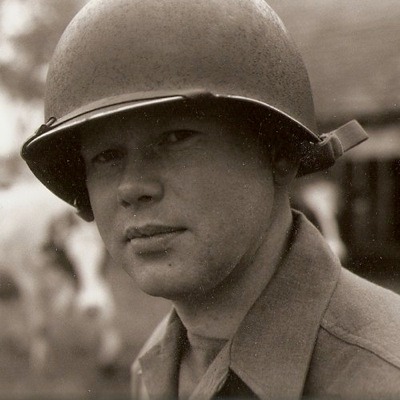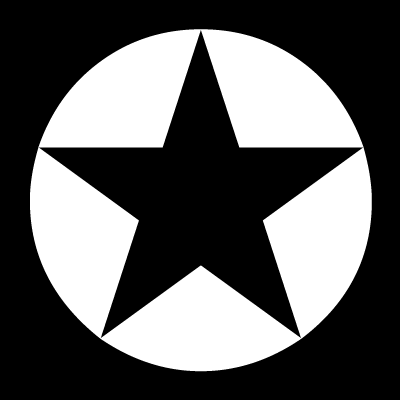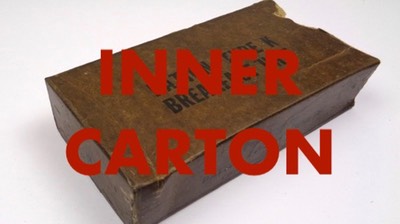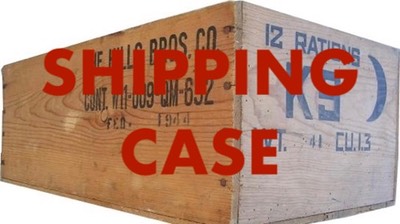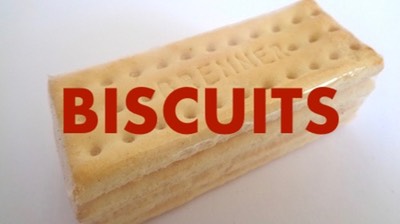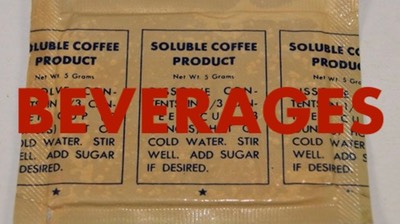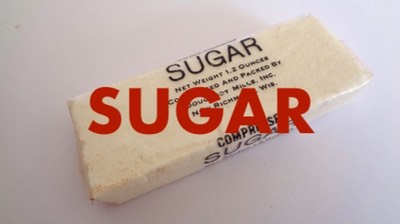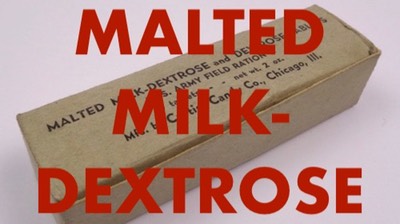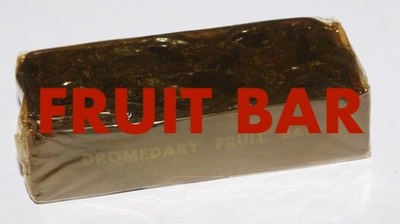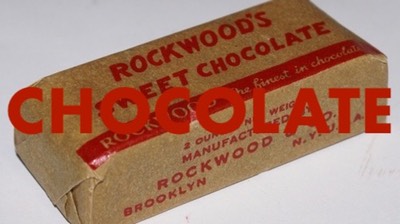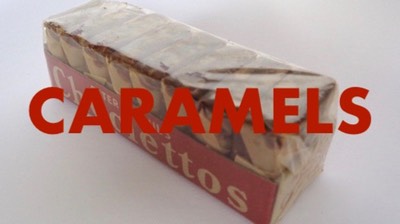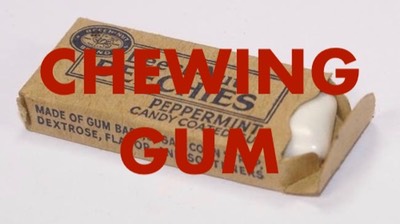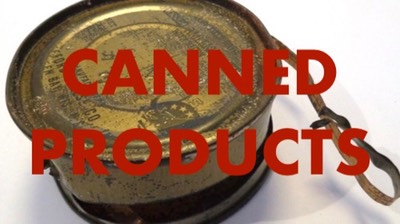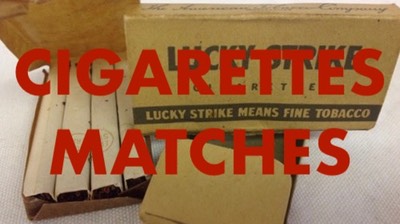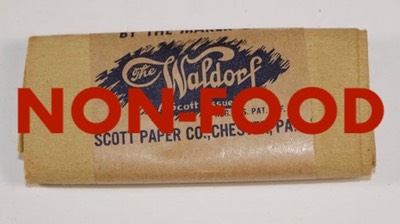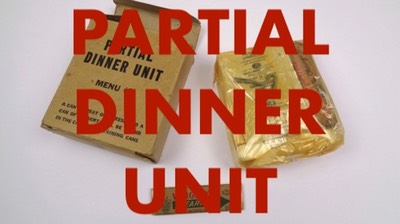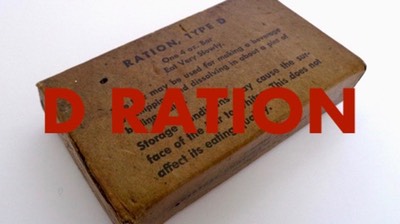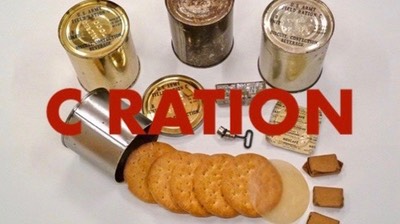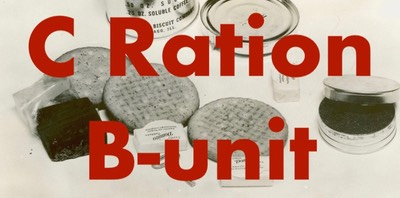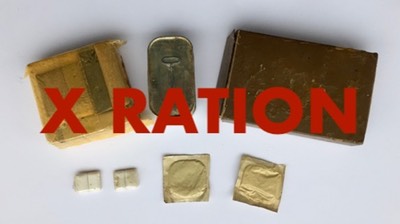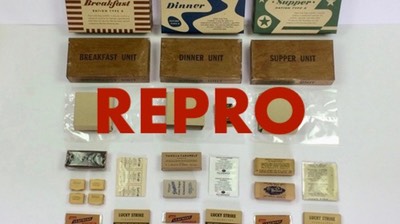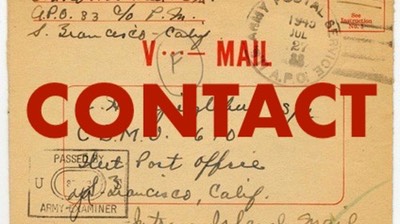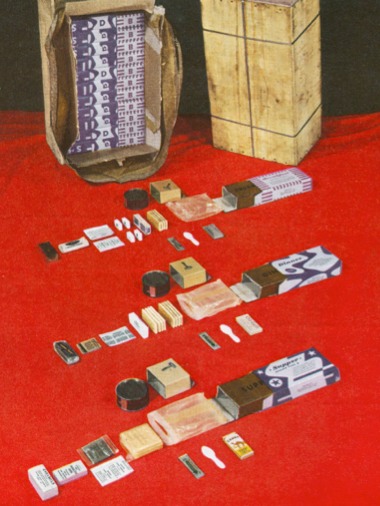
RATION, TYPE K
A Combat Ration
The original "K" Ration was developed for paratroopers inasmuch as the "C" Ration, because of its cans and weight, was not considered appropriate. The "K" Ration was therefore created to provide a good nutritional ration light in weight, and yet suitably packaged to withstand the rigors of combat. Its worth has been proven to such extent that quite often its procurement and use by the Ground Forces exceeds that of the "C" Ration.
The ration is packaged in three wax dipped units distinctively marked both as to lettering and color. The markings designate the packages as Breakfast, Dinner and Supper units. Each meal includes approximately 4 ounces of either meat, meat and egg product, or cheese spread, together with biscuits, confections, gum, and beverages with sugar. A wooden spoon, cigarettes, toilet tissue and salt tablets are also included.
Twelve rations come snugly packed in one case in order to facilitate supply where rough terrain is encountered and transportation is limited, and to provide for more successful drop from the air.
The above text is taken from the Quartermaster Corps Manual QMC 17-3 "U.S. Army support, survival, assault, combat rations and supplements" published in 1945. This illustrates the final development of the K ration.
When the German Army introduced its "Blitzkrieg" tactics, the U.S. Army found it self totally unprepared. The planning and organization for static warfare, like that in the Great War, became obsolete overnight.
With the introduction of mobile troops like the new Armored Corps with its fast reconnaissance vehicles and tanks, and vertical deployment of parachute troops, a lighter combat ration than the then standard "C" ration was needed.
Early experiments in 1941 concentrated on a pemmican biscuit supplemented with a soluble beverage powder and a chocolate bar. Although light in weight, it was unpalatable. A ration based on a pemmican biscuit as the main food used in successive meals was useless and the whole idea was "tossed out of the window".
"A ration not eaten by the men is worse than no ration at all."
By the summer of 1941 an experimental ration of three separate meals based on a canned meat and biscuits, supplemented with different beverages and confections was developed.
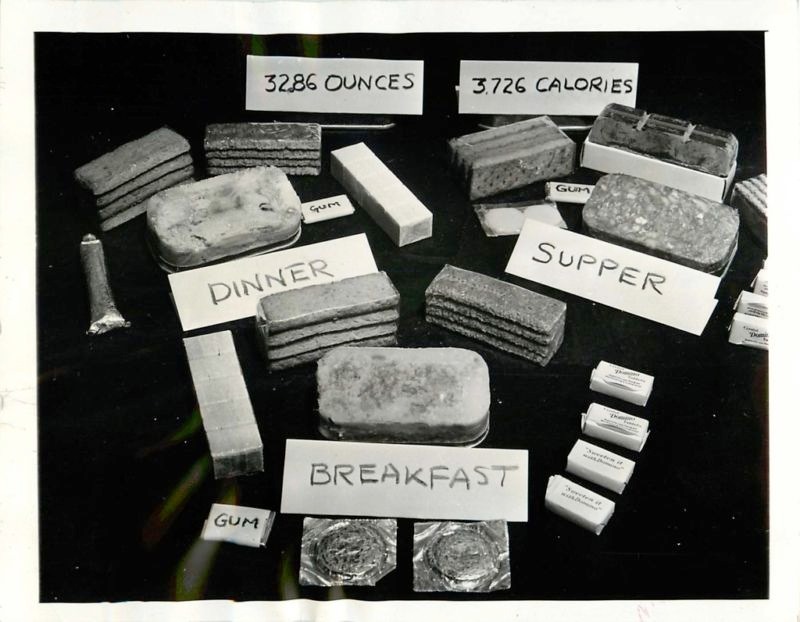
The K Ration in its experimental stage. Note that all meals have a meat product that is packed in a rectangular cut-down Spam can.
During its experimental stage this ration was often referred to as a "parachute ration". This, however, would indicate that this ration was only for parachute troops and not for other units. (Sometimes the term "parachute ration" was used to indicated that this ration was to be air dropped with a parachute.)
In November 1941 the "parachute" ration was finally adopted as a standard field ration. Although the Army labeled its ration system with the letters A, B, C and D, this new ration did not followed up with an "E".
To create a phoneticly different name, the letter "K" was chosen. It is said that the "K" was chosen to (unofficially) honor Dr. Ansel Keys, its original creator.
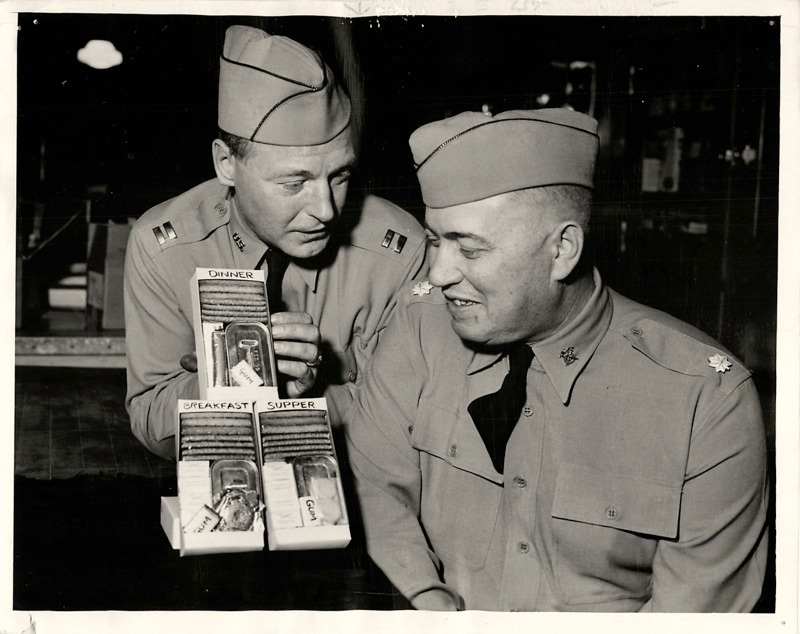
Capt. R.H MacDonnell and Lt.Col. R.A. Isker are photographed showing the new "parachure ration", October 15, 1941.
Although adopted as a standard field ration, the K Ration did not went into full production yet. Further development and large scale field test were conducted. About a year later the K Ration was considered satisfactory and large scale procurement was approved.
Its most distinctive feature is that it was packed in three cardboard boxes. One box containing a complete meal. Each meal consisted of two types of small biscuits and a can of meat. Complemented with a beverage powder soluble in hot or cold water with sugar to sweeten it. To top it off, a confection was included. This confection was some kind of candy or chocolate to raise the calorific contents of the ration. The idea was that this confection could be carried in the soldiers pocket and could be snacked on in between the meals.
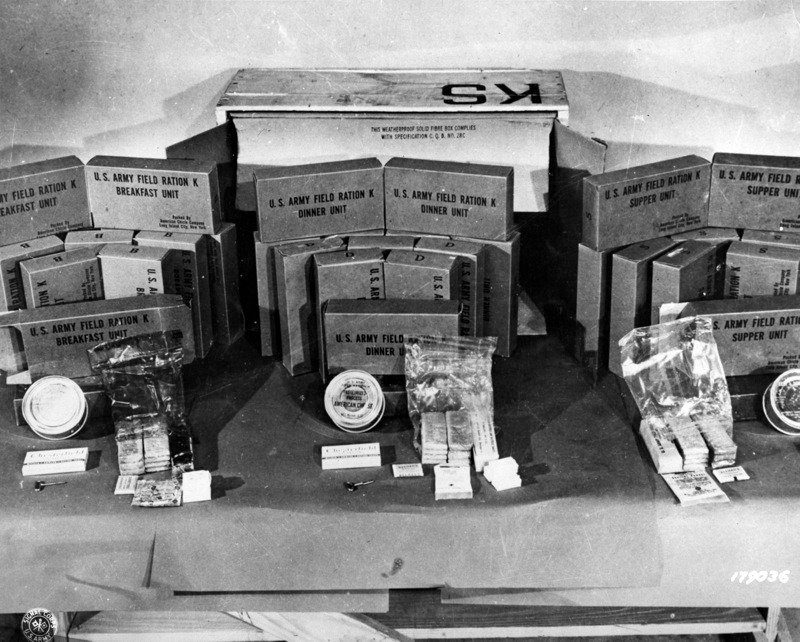
A crate of 12 K Rations (36 units) produced in 1942 is displayed here in this Signal Corps photo. Note that there are cigarettes included, but no matches yet.
It should be noted that in the U.S. Army a ration is the allowance of food for a soldier for one day. Although the K Ration consists of three boxes, one for each meal, the three units together are considered one complete ration. (As one C ration consists of six cans, two for each meal.) This, however, was not always understood and daily issue in the field was sometimes based on one box (an unit) for a day.
Although the K Ration was considered an emergency ration at first, only to be used for a few days, until the field kitchen could catch up with the advancing units. Combat experience showed that the men had to live on the K Ration for longer periods than perceived originally. It was reported from the Pacific front early in the war that the status of “emergency ration" caused it that it was not issued to the fighting man on the ground, but only issued to flying personnel of the USAAF as a bail out ration.
The main focus during development of this new ration was in providing enough energy. Most calories were provide through the inclusion of sugar, either raw or as an ingredient of the various components, and fat from the canned meat.
The ration would provide an average of 3,250 calories, although the final version of the K Ration only provided 2,830 calories, as stated in the QMC 17-3 manual.
In theory sugar is a high calorie sustenance. Although it was known in the 1940's that sugar is made of 50% glucose and 50% fructose, it was not understood that only the first provided the energy for the muscles. The latter however, is useless for the human body. So, in fact, only half of the computed calories provided by sugar is real energy.
Because most components are of a dried or condensed variety (e.g., biscuits instead of bread) and easy to digest, the food didn't gave a satisfying feeling. (It doesn't fill up). After a field test one soldier stated: "My appetite said I had eaten enough, but my stomach said it was empty."
Although eating a K Ration meal that provided enough energie, the stomach still wasn't full, leaving the soldier with a hungry feeling. Through with the inclusion of a fruit bar some fibers were added to the diet, providing a little more satisfaction and stimulates bowel movement.
The idea that the K Ration should be more than just subsistence, was proven when cigarettes and toilet paper were included. Previously rations contained only food and items like cigarettes were issued separately. With the new mobile warfare of WW2 this was not always possible and the inclusion of non food items in field ration elevated that problem somewhat.
The early war K Ration weighted approximately 2 3/4 pounds. With The extras added, the weight was finally raised to 3 pounds and 2 ounces.
Orders were awarded to companies to serve as prime contractor. These companies were issued with the latest specifications, with slight variations per contractor as directed by the Quartermaster Corps. This was done in order to prevent that several companies ordering with the same subcontractor, creating a bottleneck.
For example, if three prime contracters all order Lucky Strike cigarettes, this could cause delays with the cigarette company, because it received three different orders at the same time. Different specifications per contractor was also issued to create a little variety in the rations. While one packaging company was specified to use the cans with plain cheese, other companies were instructed to use the canned cheese with bacon.
Food for Fighters (1943)
A U.S. Army pictorial release about the food it supplied to its soldiers in the field.
Note that the K Rations assembled on the production lines are the early experimental rations with the oblong cans and the components packed loose in the box.
When an order was placed with a prime contractor (this could be for 10 million complete rations), the contractor needed time to set up a production line and place orders with subcontractors. Boxes needed to be printed, canned goods produced, biscuits baked, etc. (Subcontractors also needed to order packaging material for their products.) When everything was delivered at the prime contractor, then the rations could be assembled, packaged and packed.
The time needed from the award of the order to final delivery to the Quartermaster Corps could take up to three months. With the K Ration in full productions the production time was cut in half when assembly lines were kept running without interruption.
"Rations such as the mountain or jungle cannot be purchased on an "as wanted" basis. Requirements must be completed in advance and procurement planned in correlation with the C and K rations. This is because of the number of common components, many of which are difficult to obtain.
The specifications for these special rations must be "frozen" at a given date. Although we do not wish to deny ourselves the benefit of any new developments, the make-up of the ration cannot be changed repeatedly during the course of production. It is my feeling that suppliers must be offered the assurance of 90 days' uninterrupted production. Notice of any change should be given 30 days prior to starting on another 90 day production contract."
(Joe Blumlein to Col. Doriot, August 18, 1942)
It could take another two or three months before these K Rations were shipped and delivered at the forward depots in the theatre of operations (ETO or PTO), and then distributed to the frontline soldier.
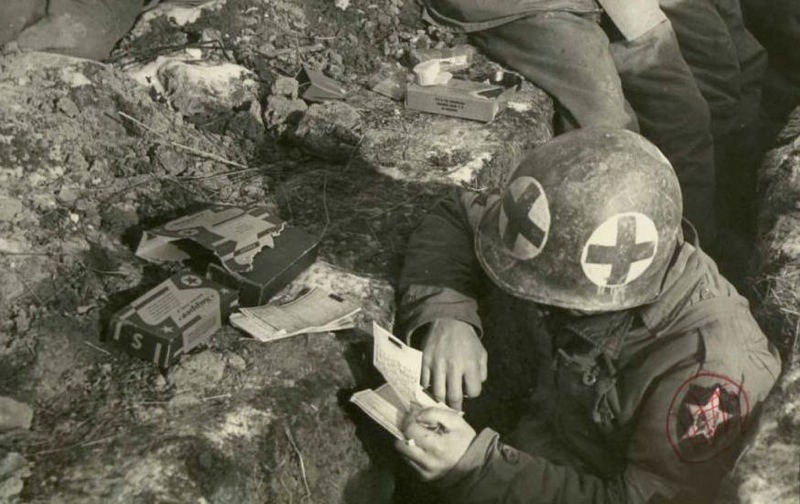
A medic from the 2nd Infantry Division is reading a letter from home. In front of him lies two late 1944 Supper unit boxes, of which one is opened. Behind him is another soldier dining on an early 1944 dinner unit, of which half a block of canned cheese can be seen sitting on the box it came in.
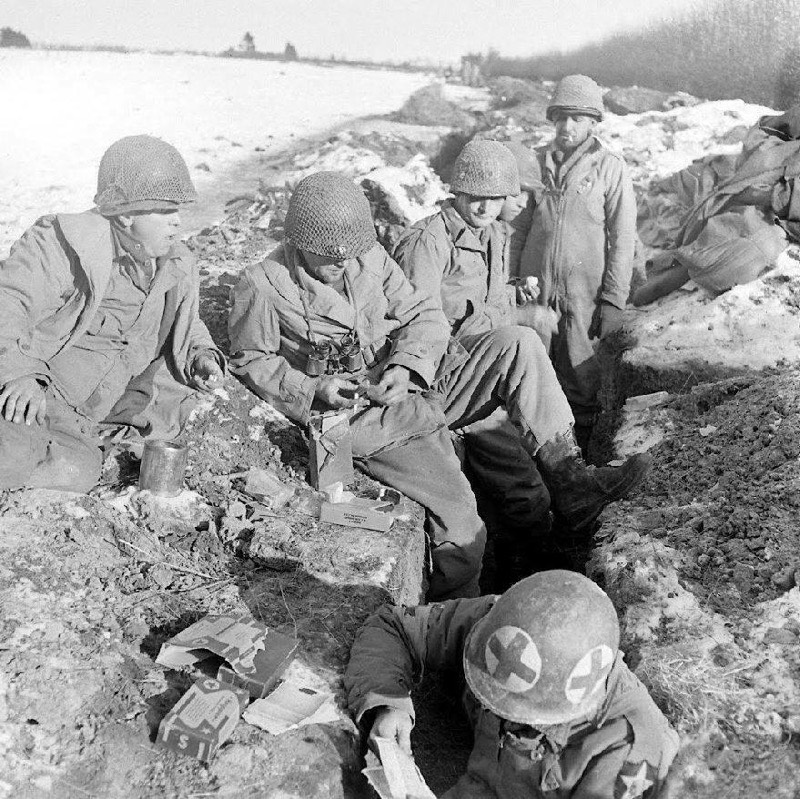
As a rule of the thump, K Rations produced according to the latest specifications, would show up at the front lines approximately three months later. The colored "morale" boxes went into production in May 1944, yet they show up at the front lines earliest late August or early September 1944.
In the following chapters I will try to explain and show its general development and its components.
The photos used for illustrations are either from own collection, found on the internet, or provided by 1944Supply.
Enjoy,
Harry.
